#steampunk technology
Text
youtube
If technology wasn’t such a central aspect of solarpunk, we’d all just be hippies redux. Yet not all tech, right? Because solarpunk is also about living the good life while building a just, inclusive, and sustainable society. So, what is solarpunk’s attitude toward and relationship with tech? How do solarpunks decide what’s worth it and what’s beyond the pale? And what’s all this about appropriate technology?
#solarpunk#Solarpunk Presents Podcast#podcast#appropriate technology#solarpunk and technology#solarpunk's relationship to technology#high tech high life#social media#blockchain#bitcoin#can bitcoin be solarpunk#can the blockchain be solarpunk#how do solarpunks use technology#how should solarpunks think about technology#solarpunk technology#steampunk technology#cyberpunk technology#cryptocurrency#can cryptocurrency be solarpunk#science fiction genre#anti-capitalism#Youtube
9 notes
·
View notes
Text

This is the Jefferson mobile fortress essentially it's a tank designed by a high elf plantation owner who has it built himself there was only one made and that was the one used by him even then it was destroyed and was really unaffective. One of the main reasons for this was instead of using an engine it literally had slaves walking set of moving platforms as a power source on top of that it was terribly made and badly designed. It has a Canon and a gatling gun further down there is also a machine gun at the very top being used by the man in the cowboy hat. I have plans to make the hi-hour plantation owner a very important antagonist within the setting but haven't fully developed the character yet.
0 notes
Note
Do you have any close ups of Tangos arm prothesis? 👀 Love all your designs so much

I presume you mean the one he has in raau. It's based off his steampunk skin. The design isn't, like, super jotted down to the fine details but these are their general designs. His second one is made of much more reflective material so its colours change with the environment more. It's definitely the most fantastical piece of medical equipment in the au, but I wanted to have some fun with it.
The first one couldn't really be worn without an undershirt, and though the second one really shouldn't be it's not as bad if he has to go without. They also had less say int he materials they got to work with for the second.
#raau ask#raau notes#raau notes: technology#raau notes: ranchers#raau notes: art#tangotek#biopunk#steampunk#character#ask art#art#sketch#colour#Hybbart
253 notes
·
View notes
Text

William Thomson's Tide Predicting Machine, 1872 (London)
Tide-predicting machine designed by William Thomson (later Lord Kelvin), built by A. Légé & Co., 20 Cross Street, Hatton Gardens, London, 1872. The machine is a mechanical analogue computer which traces the tidal curve for a given location, by combining ten astronomical components. It is the first working machine of Thomson’s design, based on his application of harmonic analysis to tidal phenomena.
Each of the ten components has a shaft with an overhead crank which carries a pulley pivoted on a parallel axis adjustable for the range applying to that place. The shafts are geared together so that their periods are broadly proportional to the periods of the tidal constituents. On each shaft the crank can be turned and clamped in any position corresponding to the epoch of tide required. The machine was able to draw the tidal curves of one harbour for one year in about four hours.
#science#history#marine#technology#tech#1800s#19th century#willian thomson#tides#oceans#water#steampunk
329 notes
·
View notes
Text

1913 Cretors Popcorn Wagon Steam Engine
Marks: 1913 Cretors popcorn steam engine 1/2 scale, R. Frederick-model engine, Quakertown, Pa. If you are going to have a popcorn wagon of course you need an engine.
23-1/2 x 14-3/4 x 10 inches (59.7 x 37.5 x 25.4 cm)
148 notes
·
View notes
Text




Steampunk themed photo collage of Walter and Barbara. So this should combine both technology and myths. :D
These are deliberately black and white images. :)
#stricklake#the sims 4#trollhunters#walter and barbara#keenswimmers2024#striklakemonth#steampunk#technology
28 notes
·
View notes
Text
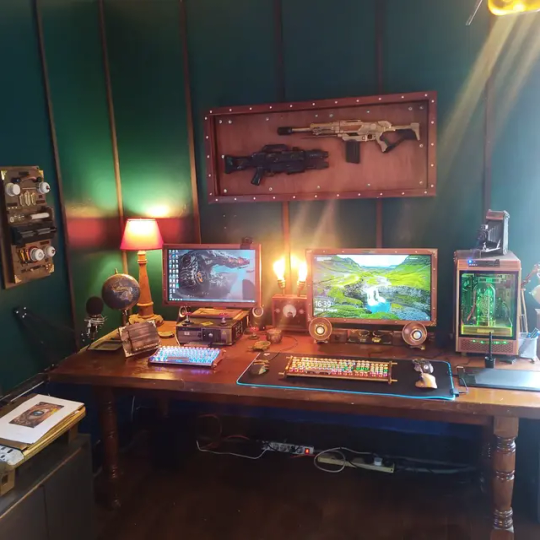
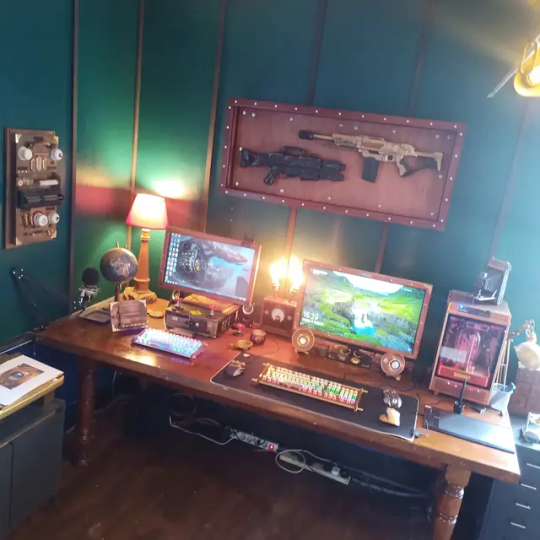
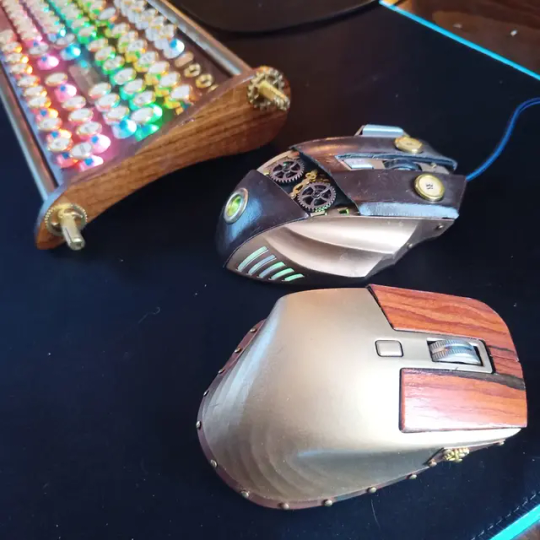


Pc setup steampunk styled
#steampunk#retro#art#pc#design#technology#uniqueaccessories#bespokedesign#home office#movie prop#warehouse13
150 notes
·
View notes
Text
Many things in Dungeon Meshi make me go "Ryoko Kui is the funniest woman alive" but obviously today I'm thinking about her decision to reveal that dwarves had/have access to crazy advanced steampunk technology that no one in the party of quasi-medieval fantasy adventurers really remarks on or ever mentions again. Unironically an excellent grasp of genre.
#dungeonposting#I do wonder if this is a lost tech of the ancients situation (Allagan style)#maybe modern dwarves have telephones they can connect to crystal scrying balls but not the dungeon's automated trolleys. etc.#also obvious allegories to world powers versus their exploited counterparts#where the long lived races have their own advanced technologies (including magic) that they're keeping from the short lived races#also before anyone comes at me yes I AM calling it steampunk#I think it's steam powered#even though aesthetically there's a case for calling it dieselpunk
32 notes
·
View notes
Text
i am SO intrigued to see what the laytonverse take on america is. The new gadgets are already so fascinating. Look at this
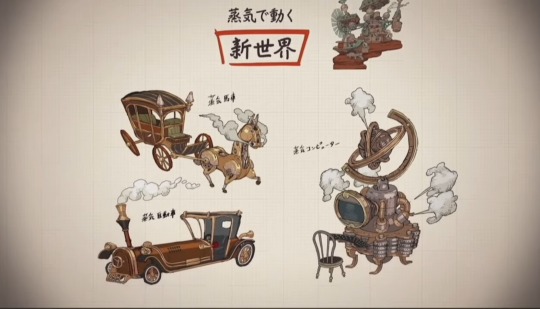
LOOK at this take on a 1930s car. and is that a computer???????? The way this could be both 1930 and 1990 ,,, LOSING my mind
and the concept of the city growing as you solve more puzzles????? BANGER
#so far the most impressive part of this game by FAR is its architecture and take on steampunk technology#boys we are FEASTING tonight#professor layton#professor layton and the new world of steam
260 notes
·
View notes
Text

more steampunk au stuff... here's the best boy jonah!!!
#mandela catalogue#jonah marshall#tmc jonah#steampunk au#hes a pilot for bps :}#very good at his job just... sometimes alternates are... a little funny when it comes to any sort of technology huh.
115 notes
·
View notes
Text
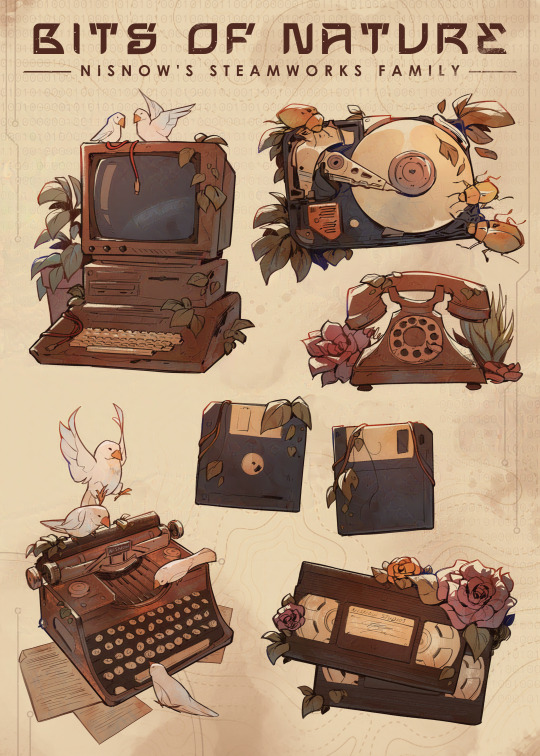
Just some little bits of nature for your timeline!
#steampunk#steamworks family#my art#my merch#sticker sheet#science#old technology#old computer#hard disk drive#casette tapes#typewriter#floppy disk#rotary phone#white zebra finch#beetle
40 notes
·
View notes
Text
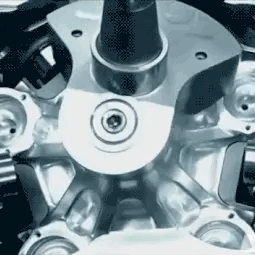

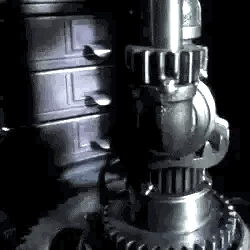
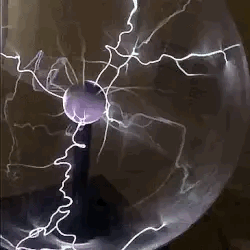




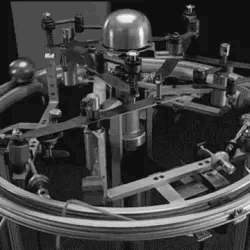
“ERROR. UNABLE TO RECOGNIZE SPECIMEN. ACTIVATING TERMINATION PROTOCOL.”
A self indulgent stimboard of THE WRECK !
🤖-🤖-🤖
🫀- x - 🫀
🤖-🤖-🤖
#stim#stimblr#stimboard#visual stim#stimmy#irl hands#black#white#monochrome#tech#technology#mech#mechanical#steampunk#robot#robotics#electricity#metal#steel#electric#doatk#diary of a tourney kid#THE WRECK#guptill89
136 notes
·
View notes
Text









handsome jack stimboard for anon
x x x / x x / x x x
#stimboard#stim#handsome jack#borderlands 2#steampunk#mask#eye#robot#technology#clothes#leather#requested
56 notes
·
View notes
Text









The Toy Soldier (The Mechanisms discography) sensory board for anon! Thank you for waiting so patiently while I ambled--this is the first sensory board where I've made the gifs myself.. I am inexperienced...
Gif sources: (📻 / 🥁 / 📻) (🥁 / 📻) (🥁 / 📻 / 🥁)
Central image: Jessica Law as the Toy Soldier
#the toy soldier#the mechanisms#requested#anon#sensory board#technology stim#gear stim#music stim#instrument stim#toy stim#clothing stim#steampunk stim#vintage stim#button stim#red stim#brown stim#hands cw#gifs cw#sensory#calming#satisfying#stimmy
51 notes
·
View notes
Text
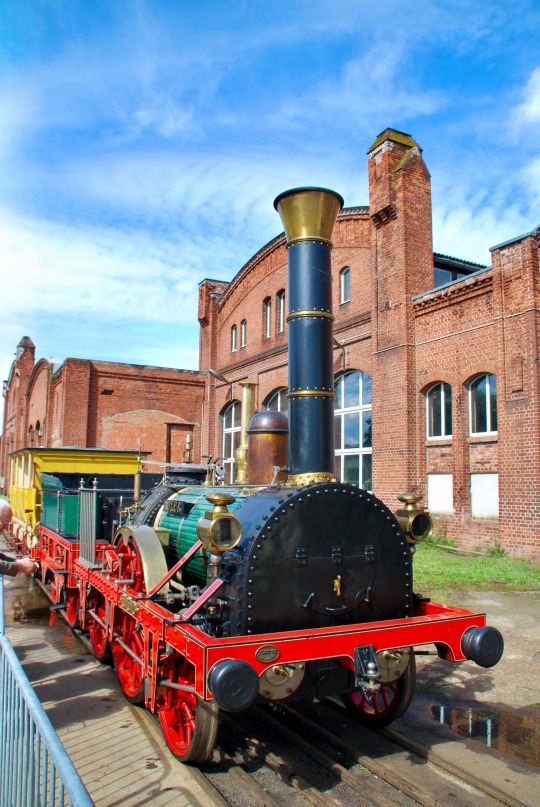
A picture of the famous German loco "Adler" ("Eagle"). It was the first steam locomotive to operate in Germany in 1835, built by George Stevenson in England. As the original loco was scrapped before 1900, the loco depicted here has been rebuilt in 1935 to celebrate 100 years of railways in Germany.
* * * * * * * * * *
Ein Foto der berühmten Dampflokomotive „Adler“, der ersten Dampflok Deutschlands. Sie wurde 1835 vom englischen Lokomotivbauer George Stevenson gebaut. Da das Original leider schon vor 1900 verschrottet wurde, ist auf dem Bild der Nachbau von 1935 zu sehen.
📸 Mine, in Meiningen.
#railway#eisenbahn#history of technology#steam locomotive#steampunk#history#museum#technology#machinery#retro#trains
61 notes
·
View notes
Text

I recently started world-building for a new story idea (I know—bad when I'm supposed to be in the middle of revising my current project) and in trying to figure out the level of technology and feeling of my new world I got lost in google searches about the different punk genres.
So I decided to make a master list.
According to Wikipedia (a highly reputable source by all accounts) a punk genre can be described as “a world built on one particular technology that is extrapolated to a highly sophisticated level (this may even be a fantastical or anachronistic technology, akin to retro-futurism) a gritty transreal urban style, or a particular approach to social themes.”
There are so many (so so many) and some people roll their eyes at every new addition but I think the names and distinctions are interesting and fun (I mean, Magicpunk may just be regular fantasy, but it sounds so much cooler). I love the idea of scientific fantasy, and of blurry the lines between the sci-fi and fantasy genres. Who’s to stop you from mixing the culture of the Japanese samurai with an epic space opera in the stars?
This is an incomplete list. I've organized it by time period (loosely, because some overlap or can go anywhere). I've also provided an example of a published work (for those that have them).
Established Fantasy Punk Genres: An Incomplete List
Magicpunk/Dungeonpunk: Fantasy punk genre where the “one particular technology” that the world is build on is magic. You have trains running on lines of sorcerer-fueled energy and ships powered by wind magic and computers running on sub-dimensional energy from the demon realm. Popular examples include The Sleeping Dragon by Jonny Nexus and The War of the Flowers by Tad Williams.
Aetherpunk: Subgenre mix of Magicpunk/Dungeonpunk where the magic source of the technology is specifically the element of Aether. Often, if not always, also has Steampunk elements. The Aeronaut’s Windlass by Jim Butcher is the only example that comes to mind.
Mythpunk: A punk genre that is inspired by or incorporates myths and legends. These aren’t usually a retelling of a popular myth, but rather one that includes elements of the myth, or twists and changes the story around to it’s own ends. Popular examples would be American Gods by Neil Gaiman or Deathless by Catherynne Valente.
Stonepunk: Set in the stone age, this genre is characterized by the use of non-technology as technology, creating pseudo-tech and modern inventions with natural, basic resources like stone, wood, water, fire, clay, and rope. The Flintstones would be the best example.
Sandalpunk: Sandalpunk is on thin ice as a punk genre. Rather than being inspired or defined by a technology, it instead focuses on the period of time of the ancient world before the Middle Ages, often set in Greece or Rome. There aren’t many examples of it. But the name is cool.
Steampunk: Arguably the most popular punk genre (after Cyberpunk) featuring science fantasy stories set in Victorian era, with advanced technology powered by steam engines and clockwork mechanics. Doctor Who perhaps described it best, “The Victorian Age accelerated. Starships and missiles fueled by coal and driven by steam.” There are many examples, both in literature and film, including His Dark Materials by Phillip Pullman, Mortal Engines by Philip Reeves and The Parosol Protectorate by Gail Carriger.
Clockpunk: Close-cousin subgenre of Steampunk, characterized by a lot of clocks and inspired by the pre-steam energy period of the Renaissance and Baroque eras. Pasquale’s Angel by Paul J. McAuley is more Clockpunk than Steampunk.
Silkpunk: Silkpunk is another subgenre of Steampunk, one generation removed. While steampunk is defined by it’s Victorian era brass and steam aesthetic, Silkpunk is inspired by East Asian culture during the period of the Silk Road. Examples include The Dandelion Dynasty by Ken Liu and The Tea Master and The Detective by Aliette de Bodard.
Cattlepunk: Yet another subgenre of Steampunk, Cattlepunk is the across-the-ocean-bastard-cousin set in the wild west of early America. Cowboys, bank robberies, and train heists meet robots, warmechs, magic, and super-weapons. The Wild Wild West and Firefly verse are classic movie examples. Book examples would be the Mistborn Era II series by Brandon Sanderson and The Dark Tower series by Stephen King. (And I didn’t realize until I just did all this research but based on examples this is like my favorite punk.)
Dieselpunk: This genre is set in the aesthetic of the 1920s-1950s era and is characterized by the use of diesel-powered technology. Commonly incorporates alternate history elements, as well as themes surrounding the Great Depression and World War II. It’s been called the darker and dirtier version of Steampunk with an emphasis on air travel and combat, dirigibles, and air pirates. Examples include The Iroon Dream by Norman Spinrad, Dreadnough by Cherie Priest, and Pirate Utopia by Bruce Sterling.
Atompunk: A retro-futuristic punk genre set in during the Cold War and characterized by atomic nuclear technology, ray guns, robots, hover cars, and interdimensional travel. Atompunk often deals with the themes of nuclear power gone wrong and alternate versions of the Cold War. The most popular example of this would be the Fallout games by Bethesda.
Capepunk: Capepunk is just superhero fiction set in the modern-era world where people have powers. Example would be any superhero story ever. I just think the name’s cool.
Gothicpunk: Gothicpunk is also usually set in the modern-era, but incorporates The Goth. Generally characterized by an underworld of supernatural creatures lying in wait and secretly controlling the workings of our world where humans are but cattle. This is basically dark Urban Fantasy, but it’s popular enough to get a distinction. Anne Rice’s Interview With a Vampire is an okay example. The movies Priest and Daybreakers are much better ones.
Cyberpunk: Cyberpunk, the grandfather of all of the punk genres. Characterized by dystopian and cynical future world in which technology has brought about cultural nihilism and a crap society. Often combined with Film Noir or detective fiction. (Fantastic Noir is a fantasy version of Cyberpunk). Heroes are most prone to be some form of hacker, rebel, or antihero fight against a totalitarian police state or corporate empire oppressing the people. Examples Neuromancer by William Gibson and the movie Blade Runner.
Post-Cyberpunk: This is Cyberpunks chipper, more optimistic sibling. It has all of the vision of a scientifically advanced cyber-culture without the gritty, dark, and edgy world elements. It still share’s the Cyberpunk elements of analyzing how technology interacts and impacts with society, just without such a grimdark view of humanity. Examples would be Agent G by C.T. Phipps and The Peace War by Vernor Vinge.
Biopunk: Biopunk is Cyberpunks genetically engineered half-sibling. This punk centers around organic technology with a healthy smattering of bio-augmentation and biotechnology. Examples include In the Courts of the Crimson Kings by S.M. Stirling, West of Eden by Harry Harrison, and Wolfish Nature by Vladimir Vasilyev.
Nanopunk: Also a subgenre of Cyberpunk with characterized by the use of nanites and nanotechnology as the predominate form of technology. Examples are Tech Heaven by Linda Nagata and Micro by Michael Crichton.
Solarpunk: Solarpunk is a genre characterized by it’s environmentally friendly technology meshed with African and Asian cultures and an emphasis in community, art, and a bright solar future where humanity has found a balance between technology and nature. Can also include many elements of Biopunk, but with a much more optomistic, for-the-future-of-species-and-environment outlook. Example works include Zahrah the Windseeker by Nnedi Okorafor, Maurai by Poul Anderson, and Songs from the Stars by Norman Spinrad.
Apunkalypse: This genre is defined by the collapse of civilization where society is replaced by lawless bands of roving scavenger gangs or cities collapsing into decay or the rise of punks overthrows the rules of the past. Examples include Mad Max and Mortal Engines by Philip Reeves (which is also Steampunk, so it’s a good example of book incorporating more than one punk genre).
Desertpunk: Punk genre characterized by sand. Who doesn't love a good desert planet? Often features roaming tribes, wandering heroes, desert bandits, and sand storms. Can be combined with Cattlepunk, for a Western desert, or Apunkalypse, for an-after-the-end-of-the-world setting. Examples include Dune by Frank Herbert and Railsea by China Mieville.
Oceanpunk: This punk is set on the high seas. Often features floating cities of wood and iron lashed together and mighty nations fighting for dominion of the watery world and may also feature civilizations and cultures below the waves in underwater cities. Sometimes called Pirate Punk, because nothing breed pirate stories like ocean cities and sailing ships. Examples include The Scar by China Mieville, Tranquilium by Andrey Lazarchuk, and Dark Life by Kat Falls.
Did I Miss a Punk?
Can you guys think of any other punks to add? Either ones you've thought up, or any you've heard of that I don't have listed. I'd love to keep this list updated. I find it's useful to look through when creating a new world to get the overall feeling of what I'm going for with the story and world-building.
What punk are you writing in for your current WIP?
#worldbuilding#fantasy writing#steampunk#cyberpunk#punk genres#fantasy and science fiction writing#worldbuilding advice#writing resouces#worldbuilding inspiration#fantasy worldbuilding#fantasy magic systems#magic and technology#my stuff#worldbuilding stuff
10 notes
·
View notes